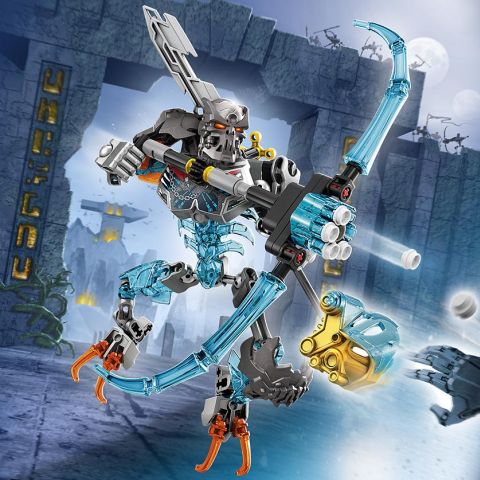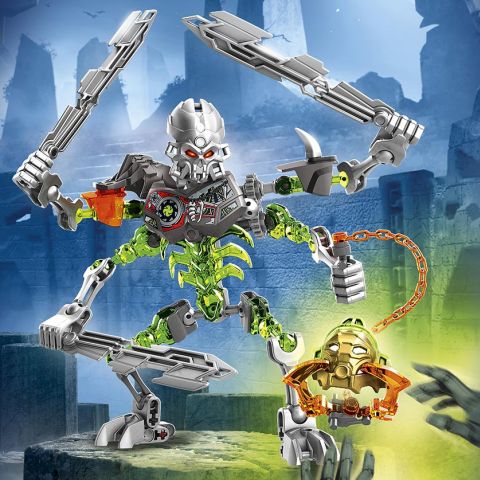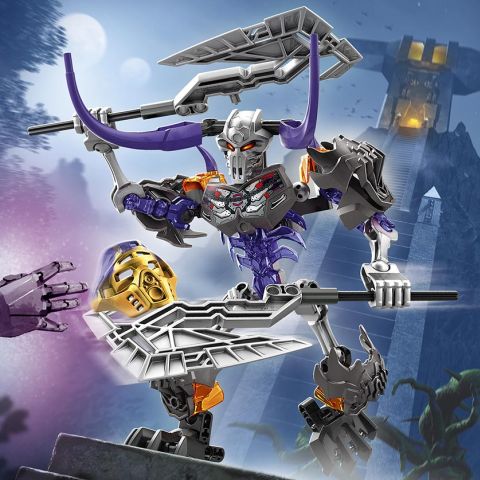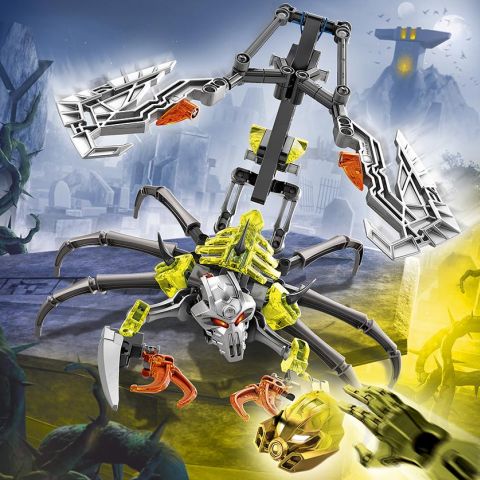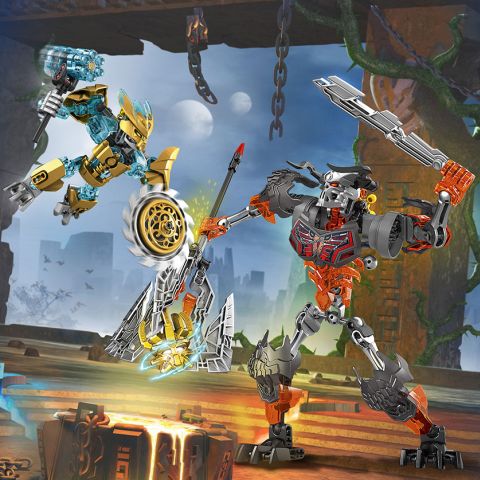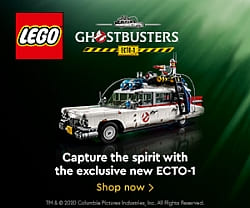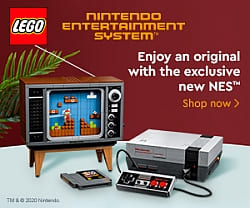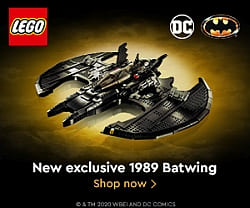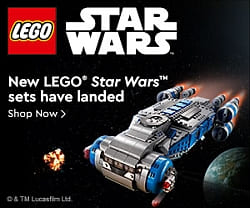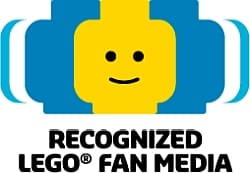The #70751 LEGO Ninjago Temple of Airjitzu is the largest LEGO Ninjago set ever released, so there is a lot to talk about. It took me five hours to build the set, and probably just as much to write this review. So settle in, and let’s begin. While Ninjago’s target audience is mostly kids, this set is definitely going to be of great interest to adult LEGO fans as well. Let me say this right now; it is a gorgeous piece of art, worthy of not just play, but display. I could certainly see it not just in a child’s play-room, but in a serene meditation-room. And when you read the story behind how the set was designed there are some instances of serendipity, which makes this beautiful temple even more mysterious and special. 🙂
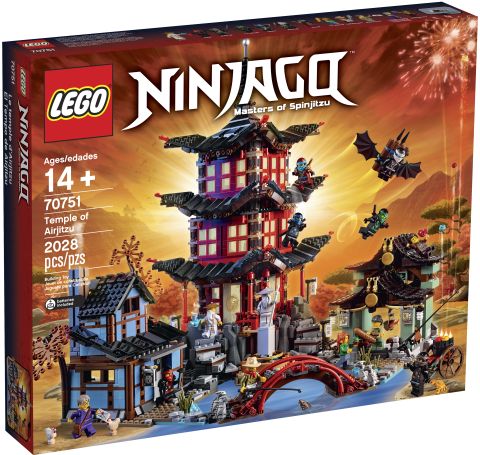
➡ LEGO NINJAGO TEMPLE OF AIRJITZU – DESCRIPTION: Join the Ninja at the beautiful Temple of Airjitzu! Enjoy the ultimate LEGO NINJAGO building experience as you construct the majestic Temple of Airjitzu and surrounding village! The highly detailed Temple building has many delightful architectural features including Oriental–style decorated windows and sliding doors. The intricate wooden-frame-style walls of the nearby Blacksmiths and beautiful curved roofs of the Smugglers Market will also test your LEGO building skills. And with every Ninja included in one set for the first time, plus loads of other key characters, you can role-play all your favorite NINJAGO adventures. Take tea in the reception area of the Temple, practice your Ninja moves in the training room or join Wu in his study to read or paint. Discover the Ninja glider upstairs at the Blacksmith’s workshop, cross the bridge guarded by the stone dragons and seek out hidden treasure at the Smugglers’ Market. Then turn off the lights in your room to watch the Temple’s illuminated spinning shadow theater! Includes 12 minifigures with assorted weapons: Lloyd, Kai, Jay, Zane, Cole, Nya, Wu, Misako, Dareth, Postman, Jesper and Claire. 2028 pieces. Price: $199.99 – BUY HERE
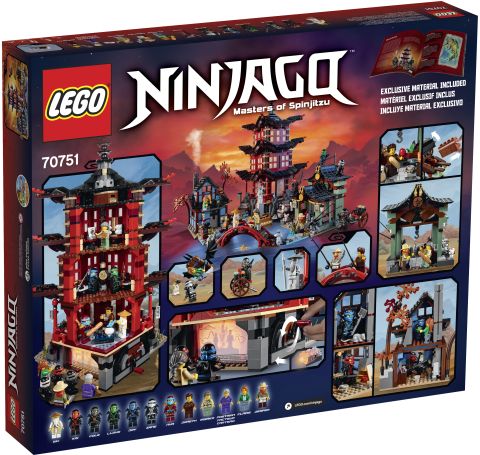
➡ LEGO NINJAGO TEMPLE OF AIRJITZU – BOOKLET: The set comes with a very thick, 283 page book. It is made of the same type of good quality but thin paper as most LEGO instructions, so you have to be a bit careful turning the pages to make sure you don’t rip them. The booklet is packaged in fully sealed plastic wrapping, so it is unlikely it will get damaged in the box (in fact, my set arrived in a destroyed box that was pushed together like a harmonica, and the booklet – and all the pieces – survived pretty much unscratched). The first 11 pages of the booklet contain extra information about the history of the temple in the world of Ninjago, the characters, the design process, an interview with the designer, and some interesting information about the shadow theater.
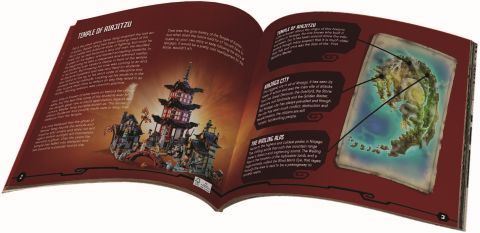
There are some curious details here. For example the temple is presented as a ghostly hunted ancient ruin with the story of the Airjitzu Master Sensei Yang and his disciples who kept disappearing – thus the ghost stories. Also, while in the designer-video Jesper was featured as a shopkeeper, in the booklet he is the groundskeeper for the temple. And instead of Claire being a tourist, here she is Jesper’s daughter.

I found the interview with the designer, Adrian Florea, the most interesting. He shares that the main idea for the model and the layout was to provide the Ninjago characters with an environment where they could take a break from saving the land of Ninjago. He also shares some early sketches from the design process, the challenges faced during designing the set, how the idea for the shadow theater came about, and more. I won’t share the details because I don’t want to spoil the experience for you, but it is definitely an interesting read, and I’m glad it was included. The only thing I thought would have been nice to add is a bit about the design and function of pagodas.
➡ LEGO NINJAGO TEMPLE – BUILDING EXPERIENCE: I will talk about this more as we walk through each section, but I thought to mention some general points here. The set is huge: measures over 16” (42cm) high, 20” (52cm) wide and 13” (35cm) deep. As I mentioned at the beginning, it took me five hours to build it, but it was not boring or repetitive at all. However is not a set you want to try to speed-build. The fact that the temple and the grounds around the temple are all built in an angle, really messes with your mind and you have to pay special attention to the building-steps for these sections. LEGO thoughtfully included some lime-green 1×1 round plates when you start building these areas (which are invisible at the final model) to help you as guides. The set has a modular design. The temple, the two smaller structures and the bridge are all separate and can easily be disconnected from each other. This is helpful to move the set around, or for fixing things when you knock something over.
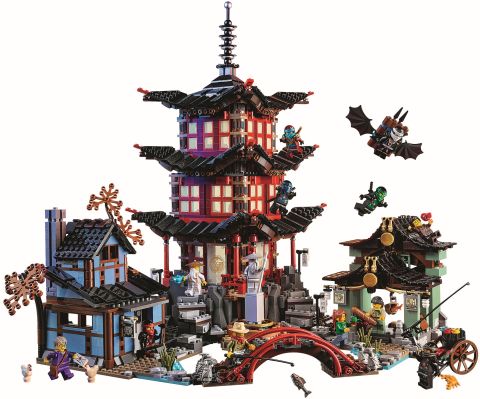
➡ LEGO NINJAGO TEMPLE – SMUGGLER’S MARKET: This is the first building you will be assembling in the set. While it has open walls with a simple design, the roof section is unusually complex. This is not just to provide a frame for the curved roof, but also to keep such a light structure together – works very effectively. Inside the market is one of my favorite details in the entire set; the sink made by using an upside-down miner’s helmet (see video-review below for details). The roof is the highlight of this building, using garage-doors that can be flipped back to reveal the hidden treasure-chests. It is a simple and effective design, although I have found the roofs a bit too shallow and added a couple of additional cheese-slopes to increase the curve. In front of the market is a bit of pathway and a small pond area with those brand new olive-green grass pieces (you get 13 + 3 extras in the set). The chickens are great and makes the whole set more village-like. Have you noticed that every LEGO set that has the chickens is awesome? 😀
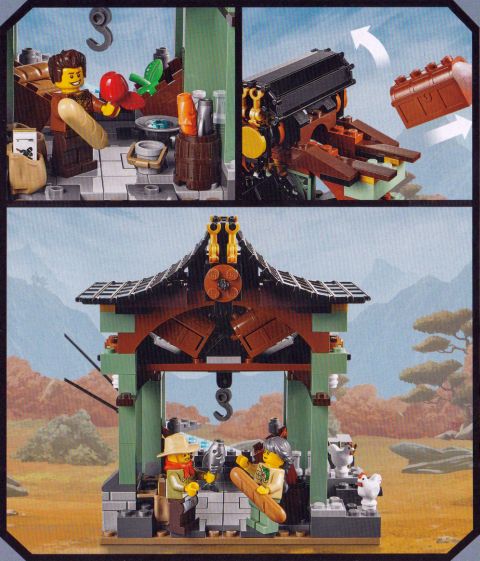
➡ LEGO NINJAGO TEMPLE – BLACKSMITH’S SHOP: This is the second building you will be assembling. It uses the same wood-frame building-style (and also the same color) as the blue buildings in the #10193 LEGO Medieval Market Village, and the #10223 LEGO Kingdoms Joust set. There is some clever sideways building for the windows, and upside-down building for the chimney. I love the fireplace at the bottom floor using car doors! As you will see in the video-review below by Jason from the BrickShow, the second floor is empty, but this is where the ninja glider supposed to be stored – I guess Jason didn’t notice that. The second floor is modular and easily removable. Also, the roof of the second floor opens up. The trees are very lovely, however a few additional leaf elements could be added to hide some of the more unsightly parts of the assembly. What I don’t like is the sticker on the door. The design just doesn’t blend well with the light-gray door itself – it just looks like a sticker on a door. This building also has a bit of pathway and a small watery area at the front.
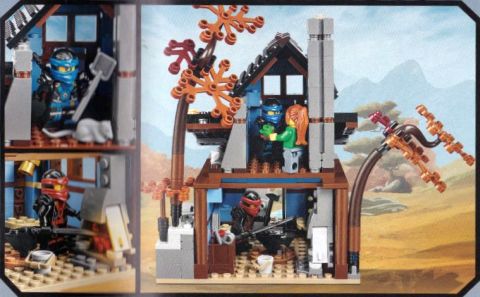
➡ LEGO NINJAGO TEMPLE OF AIRJITZU – BRIDGE & POND: This beautiful little bridge is what connects the two sides of the whole layout. It is not connected to the other sections, but simply sits in between them. I think the dragons suppose to be facing out – I have never seen a bridge where the protectors are facing in – but this can be easily fixed by just turning them around. Since we are talking about the bridge over the pond, I would add here that one of my only criticism for this set is that in my opinion the water would have been nicer in a translucent blue color, instead of azure. I think even regular blue would have worked nicer. Azure is not bad, but a bit too bright and unnatural looking. But that’s just my opinion.

➡ LEGO NINJAGO TEMPLE – ROCKWORK & STATUE: The rockwork is mostly under the main temple, but it is also scattered under and around the other buildings to make them look more ancient. While two large rock-pieces (BURPs) have been used to build up the bulk of the rock under the temple, they are so well integrated, you will never notice them. And I really have to talk about those steps! Although they look like they might crumble at any time, the construction is ingenious and very sturdy, using those new plates shaped like an “A”. I have only seen such detailed crumbled looking rockwork by AFOLs (adult fans of LEGO) with no cutbacks or shortcuts on piece usage and design. The statue is that of Airjitzu Master Sensei Yang, and this is the focal point of the set. I like how the edges of the base are elevated, so if you decide to build up the whole center pond area with plates to resemble more water, you can do that without much trouble. The only unfortunate thing is that while the statues body is light-gray, the hands are dark-gray. I’m not sure why this is, as light-gray hands are not rare.
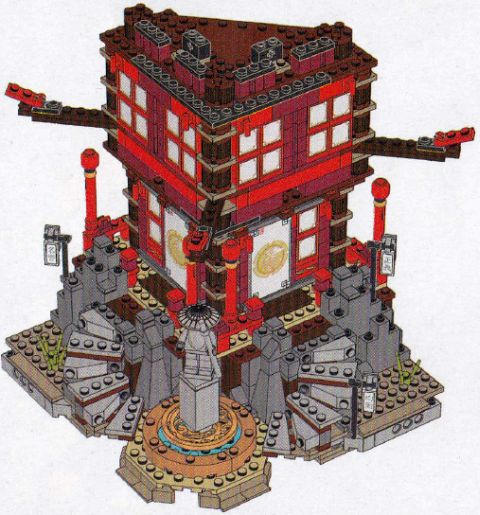
➡ LEGO NINJAGO TEMPLE OF AIRJITZU – SHADOW THEATER: On the inside of the rockwork is the shadow theater that you can see from the back. The whole idea and assembly is so unique that a entire separate review could be dedicated to it. It is interesting to note that it was added later in the design process, which makes me wonder what was planned there before. I’m glad it was added though as it is just stunning, and this is one of the reasons I said that this set is a piece of art. The shadow theater is also customizable – meaning, you can add your own arrangements with interesting elements by removing the front plastic screen. In fact, the designer encourages you to do that. One thing I would suggest is that if you are planning to display this set on a shelf, you place it on some kind of sheet that makes it easier to turn around and see the shadow theatre and the inside of the buildings.
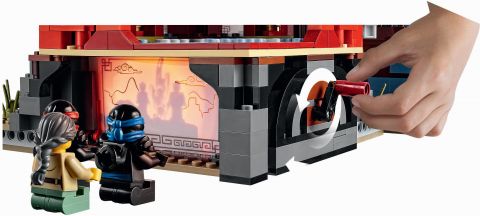
➡ LEGO NINJAGO TEMPLE OF AIRJITZU – TEMPLE: The shadow theater is basically in the basement of the main temple, or in a cave under the temple – it is up to your interpretation. The main temple structure starts elevated and goes three stories high. The first floor is the reception area, and while this room is pretty much empty, it does have some nice features in the form of the two sliding doors and the lovely mosaic-work on the floor using sand-blue and light-gray pieces. There is also a balcony around this floor which gives access to the two doors and the two staircases. The second floor is the training-room, the third floor is Sensei Wu’s study, and there is also a small attic. You can see the details of all of these rooms in the video-review below, so I will just focus on the structure itself.
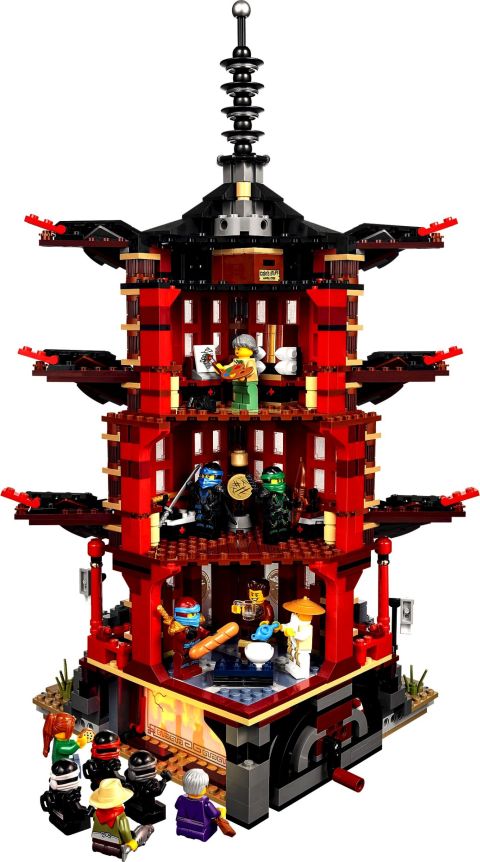
The most iconic detail of the temple is the curved roof. The construction is so complicated that I don’t even know where to start to describe it. The designer also mentioned at the beginning of the booklet that the original idea was even more complex. I have no idea how he comes up with this stuff (I guess that’s why LEGO hires guys like him), but the end result works perfectly It is also sturdy, and can be easily removed and reattached. Note that the three levels of the roof are not the same. They are each slightly smaller as you get higher up. So the designer didn’t just have to come up with a complex design, but had to make a smaller version for each level.
The finial at the top is made of balls and train wheels, topped with a final silver ball. It is simple, but looks really good. I was reading on Wikipedia that this finial is often called a “demon arrester”, and if made of metal can function as a lightning-rod. Apparently pagodas often attract lightning strikes because of their height. The windows and doors on the temple are printed to make them look like rice-paper. Most other decorations in the set (flags, floor designs in the temple’s 2nd and 3rd floors) are stickers.
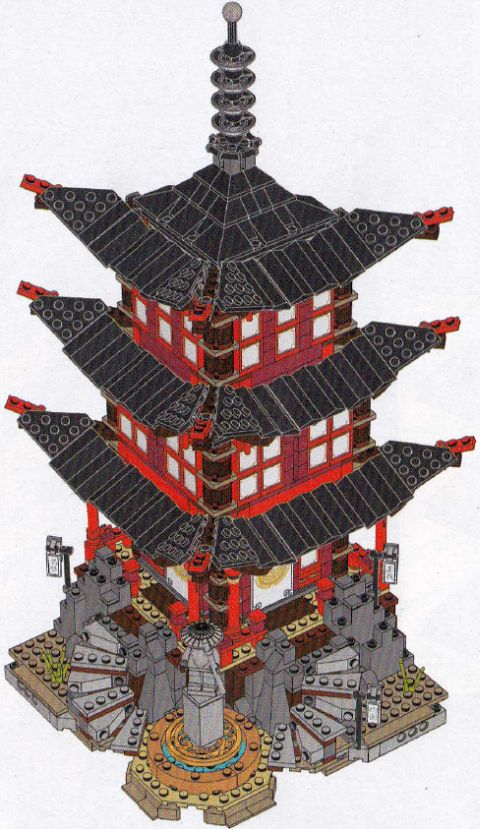
While I have very little complaints about this set, I do have one major one. Most people will likely never even notice it, but I’m the daughter of an architect and it bothers me. Pagodas are tiered structures built in the shape of a stupa; a tomb-like structure where sacred relics are displayed and kept safe. While pagodas look fancy because of the unique roofs, intricate decorations, and lively colors, the structures themselves are actually quite simple; floors stacked on top of each other either straight up or slightly tapered in as the floors go up. This is one of the simples architectural design to build a multilevel building. The main corner beams supposed to be on top of each other, or slightly in for structural stability.
In the LEGO Ninjago Airjitzu Temple, some compromises were made to allow the wrap-around porch on the first floor. The structural beams are set in so there is room for the porch. The main beams on the second floor however jot out by a stud on each side to create a bigger room, then on the third floor the beams are back in again. This is not structurally sound. It is the first floor that should have been the widest, gradually tapering as the floors go up. The designer was well aware of this, and he mentions it in response to the question “What was the toughest part of the model to design?” He hides this problem fairly well with the smaller red columns of the porch, and it is barely noticeable from the front. However as soon as you turn the set to the side it becomes obvious that the beams on the first floor are pushed in by a stud.
I have been thinking about how to fix this and came up with a few ideas. Probably the easiest would be to just change the colors of the main beams on the first floor from brown to either red or dark red. This would visually hide the smaller footprint of the first floor and even give the illusion of a larger base because the colors would pretty much merge with the smaller outer columns. (By the way you get 30 of those dark-brown 2×2 round bricks with grooves to make the columns!). Another possible option would be to rebuild the second floor with a smaller room and thus bringing the columns in by one stud. This would bring the support columns on top of each other for all three floors, which would be structurally more realistic. The roof section could still be kept the same, however the arrangement of the windows have to be adjusted. I haven’t done either modifications yet, but I plan to do so.
➡ LEGO NINJAGO TEMPLE OF AIRJITSU – EXTRAS: There are a couple of extra items in this set as well; a ninja glider that is built in the same style as the ones in the ninja sets of the ’90s – a nice nostalgic piece. The other extra is a small cart with fireworks, using the new rapid-shooter piece. It is quite fun!
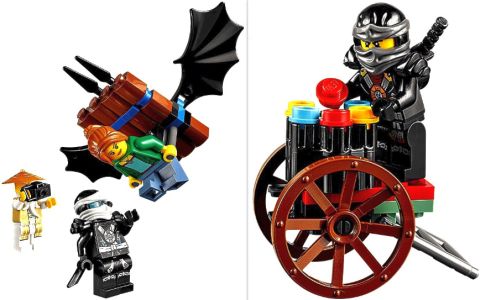
➡ LEGO NINJAGO TEMPLE OF AIRJITZU – MINIFIGURES: There are twelve minifigures in this set, and this is the only set that includes the entire ninja team. We get all five ninja (Jay, Cole, Kai, Zane and Lloyd), as well as Nya, Sensei Wu in a beautiful new robe, and Misako. It is unfortunate that Sensei Garmadon was not included. However we do get some other extras in the form of Dareth in a new ninja suit, Jasper and Claire (with contradictory identities, as I mentioned at the beginning), and the Postman. While the Airjitzu suits for the ninja are nice, this set would have hugely benefited from having the ninja in more everyday outfits. After all the whole point of this set is that this is the place where the ninja can unwind.
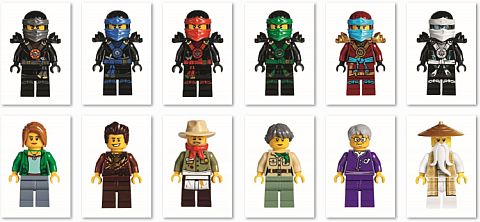
➡ LEGO NINJAGO TEMPLE OF AIRJITZU – PARTS: I have mentioned several of the unique and rare elements already, including the printed doors and windows, the sand-blue and sand-green pieces, dark-brown round bricks with grooves, olive-green grass pieces, rust colored leaves, etc. There are also 4+2 extra chrome-gold rings from the LEGO Lord of the Rings sets, and plenty of weapons, including quite a few extras. All in all you get 2028 parts, and they are all either interesting, useful or rare.
I will say this one more time; this set is a gorgeous piece of art. The angled layout is unusual and beautiful. The whole setup looks like a dreamy painting, which is only enhanced by the inclusion of the shadow theater. While the set has plenty of play-features that kids can enjoy, it actually looks best on display with only one or two minifigs, or no minifigs at all. You will have to think about how to display it given its size, unusual shape, and the fact that you have to turn around the set to operate and see the shadow theater. The are a few minor things that could have been done a bit better and I have mentioned those in the sections above. The two main things being the placement of the main columns and the outfits of the ninja. The rest can be fixed/modified easily if you choose to.

If you are a LEGO Ninjago fan, this is the ultimate set to get. I know it is expensive, but with over two thousand pieces the price is fair. Perhaps this is the big set to save up for a special occasion. If you are not a Ninjago fan, but like Asian designs, you will be very pleased as well. The style of a traditional pagoda is well represented and the whole layout is just beautiful. The building-experience itself is interesting and challenging due to the layout. I would say that it is a bit more challenging that a LEGO Modular Building, but less challenging than a LEGO Technic set. The recommended age is 14+ which I think is set a tad too high. My feeling is that a mature 12-year-old and above would enjoy both the building experience and the style. Below I included the review from the BrickShow to give you a second opinion:
I hope you found this review – as well as the review of Jason from the BrickShow – helpful in deciding if the #70751 LEGO Ninjago Temple of Airjitzu is for you. The set is scheduled for release on September 1st, but it is already available for LEGO VIP members at the Online LEGO Shop.

So what do you think? How do you like the LEGO Ninjago Temple of Airjitzu? Did you get it already? Or are you planning to? Feel free to share your own review and thoughts on this set in the comment section below! 😉
And you might also like to check out the LEGO Ninjago section for more news, reviews and discussions, or select from the following recent posts:
- LEGO Ninjago Temple of Airjitzu Available Now!
- LEGO Ninjago – 2015 Summer Sets Reviews
- LEGO Ninjago Season 6 Sneak-Peek!
- LEGO Ninjago Temple of Airjitzu Coming!
- LEGO Ninjago 2015 Sets Reviews
- LEGO Ninjago Airjitzu Flyers Available Now!
- LEGO Ninjago Season 5 – TV Schedule
- LEGO Ninjago Season 5: Possession – Trailer
- LEGO Ninjago Shadow of Ronin Video-Game


